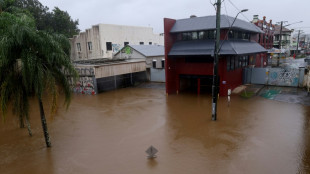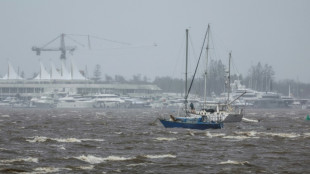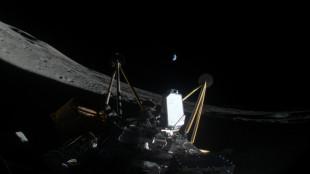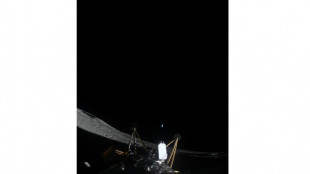
-
 Argentina searches for baby, young sister swept away by floods
Argentina searches for baby, young sister swept away by floods
-
Stock markets slump on US economic fears

-
 UN chief says 'poison of patriarchy' is back with a vengeance
UN chief says 'poison of patriarchy' is back with a vengeance
-
UBS fined 75,000 euros in France for harassing two whistleblowers

-
 Stock markets slump on US, China economic fears
Stock markets slump on US, China economic fears
-
Major fuel shortage hits black gold producer Niger

-
 Musk spat renews opposition in Italy to Starlink deal
Musk spat renews opposition in Italy to Starlink deal
-
Stock markets mainly lower on China, US economy fears

-
 Former Ubisoft bosses on trial in France over alleged harassment
Former Ubisoft bosses on trial in France over alleged harassment
-
Strike action grounds thousands of flights in Germany

-
 Trump says US in talks with four groups over TikTok sale
Trump says US in talks with four groups over TikTok sale
-
Hong Kong, Shanghai lead losers on mixed day for markets

-
 'Got cash?' Tunisians grapple with new restrictions on cheques
'Got cash?' Tunisians grapple with new restrictions on cheques
-
Russian disinformation 'infects' AI chatbots, researchers warn

-
 'Quite sad': Renters turn to lottery in Spain's housing crisis
'Quite sad': Renters turn to lottery in Spain's housing crisis
-
Indonesians seek escape as anger rises over quality of life

-
 Iran says won't negotiate under 'intimidation' as Trump ramps up pressure
Iran says won't negotiate under 'intimidation' as Trump ramps up pressure
-
7-Eleven, Couche-Tard explore sell-offs ahead of potential merger

-
 Trump admin detains pro-Palestinian campus protest leader
Trump admin detains pro-Palestinian campus protest leader
-
Japan auctions emergency rice reserves as prices soar

-
 Hong Kong, Shanghai lead losers on mixed day for Asian markets
Hong Kong, Shanghai lead losers on mixed day for Asian markets
-
China-US trade war heats up as Beijing's tariffs take effect

-
 7-Eleven to explore sell-offs with Couche-Tard ahead of potential merger
7-Eleven to explore sell-offs with Couche-Tard ahead of potential merger
-
Shareholders of Regeneron Pharmaceuticals, Inc. Should Contact Levi & Korsinsky Before March 10, 2025 to Discuss Your Rights - REGN

-
 'So important': Selma marks 60 years since US civil rights march
'So important': Selma marks 60 years since US civil rights march
-
Black comedy from award-winning 'Parasite' director tops N.America box office

-
 EU chief sees US as 'allies' despite 'differences'
EU chief sees US as 'allies' despite 'differences'
-
French research groups urged to welcome scientists fleeing US

-
 Journalist quits broadcaster after comparing French actions in Algeria to Nazi massacre
Journalist quits broadcaster after comparing French actions in Algeria to Nazi massacre
-
Highlights from Paris Women's Fashion Week

-
 US ends waiver for Iraq to buy Iranian electricity
US ends waiver for Iraq to buy Iranian electricity
-
China-US trade war heats up with Beijing's tariffs to take effect

-
 Greenland's Inuits rediscover their national pride
Greenland's Inuits rediscover their national pride
-
Floods, mass power cuts as wild weather bashes eastern Australia

-
 Wild weather leaves mass blackouts in Australia
Wild weather leaves mass blackouts in Australia
-
China consumption slump deepens as February prices drop

-
 Phone bans sweep US schools despite skepticism
Phone bans sweep US schools despite skepticism
-
Some 200 detained after Istanbul Women's Day march: organisers

-
 'Grieving': US federal workers thrown into uncertain job market
'Grieving': US federal workers thrown into uncertain job market
-
Remains of murdered Indigenous woman found at Canada landfill

-
 Women will overthrow Iran's Islamic republic: Nobel laureate
Women will overthrow Iran's Islamic republic: Nobel laureate
-
Women step into the ring at west African wrestling tournament

-
 Trump's tariff rollback brings limited respite as new levies loom
Trump's tariff rollback brings limited respite as new levies loom
-
Hackman died of natural causes, a week after wife: medical examiner

-
 Oops, we tipped it again: Mission over for sideways US lander
Oops, we tipped it again: Mission over for sideways US lander
-
Cyclone Alfred downgraded to tropical low as it nears Australia

-
 Global stocks mixed as Trump shifts on tariffs weighs on sentiment
Global stocks mixed as Trump shifts on tariffs weighs on sentiment
-
Trump says dairy, lumber tariffs on Canada may come soon

-
 Trump cuts $400 mn from Columbia University over anti-Semitism claims
Trump cuts $400 mn from Columbia University over anti-Semitism claims
-
US Fed chair flags policy uncertainty but in no rush to adjust rates

| RBGPF | 5.38% | 70.21 | $ | |
| CMSC | -0.26% | 23.05 | $ | |
| SCS | -0.99% | 11.615 | $ | |
| BCC | -0.77% | 100.84 | $ | |
| NGG | 2.5% | 62.39 | $ | |
| GSK | 1.71% | 40.745 | $ | |
| RELX | -1.27% | 47.495 | $ | |
| RIO | -0.23% | 62.17 | $ | |
| BTI | -0.37% | 40.75 | $ | |
| CMSD | -0.28% | 23.265 | $ | |
| BP | 0.71% | 32.3 | $ | |
| AZN | -1.19% | 76.59 | $ | |
| RYCEF | -8.53% | 9.5 | $ | |
| VOD | 1.15% | 9.53 | $ | |
| BCE | 1.55% | 25.19 | $ | |
| JRI | 1.85% | 12.99 | $ |

Long lost moon could have been responsible for Saturn's rings
Discovered by Galileo 400 years ago, the rings of Saturn are about the most striking thing astronomers with small telescopes can spot in our solar system.
But even today, experts cannot agree on how or when they formed.
A new study published Thursday in the prestigious journal Science sets out to provide a convincing answer.
Between 100-200 million years ago, an icy moon they named Chrysalis broke up after getting a little too close to the gas giant, they conclude.
While most of it made impact with Saturn, its remaining fragments broke into small icy chunks that form the planet's signature rings.
"It's nice to find a plausible explanation," Jack Wisdom, professor of planetary sciences at MIT and lead author of the new study, told AFP.
Saturn, the sixth planet from the Sun, was formed four and a half billion years ago, at the beginning of the solar system.
But a few decades ago, scientists suggested that Saturn's rings appeared much later: only about 100 million years ago.
The hypothesis was reinforced by observations made by the Cassini probe, which orbited Saturn from 2004 to 2017.
"But because no one could think of a way to make the rings 100 million years ago, some people have been questioning the reasoning that led to that deduction," said Wisdom.
By constructing complex mathematical models, Wisdom and colleagues found an explanation that both justified the timeline, and allowed them to better understand another characteristic of the planet, its tilt.
Saturn has a 26.7 degree tilt. Being a gas giant, it would have been expected that the process of accumulating matter that led to its formation would have prevented tilt.
- Gravitational interactions -
Scientists recently discovered that Titan, the largest of Saturn's 83 moons, is migrating away from the planet, at a rate of 11 centimeters a year.
This changes the rate at which Saturn's axis of tilt loops around the vertical -- the technical term is "precession." Think of a spinning top drawing circles.
Around a billion years ago, this wobble frequency came into sync with Neptune's wobbly orbit, creating a powerful gravitational interaction called "resonance."
In order to maintain this lock, as Titan kept moving out, Saturn had to tilt, scientists argued.
But that explanation hinged on knowing how mass was distributed in the planet's interior, since the tilt would have behaved differently if it were concentrated more at its surface or the core.
In the new study, Wisdom and colleagues modeled the planet's interior using gravitational data gathered by Cassini during its close approach "Grand Finale," its last act before plunging into Saturn's depths.
The model they generated found Saturn is now slightly out of sync with Neptune, which necessitated a new explanation -- an event powerful enough to cause the drastic disruption.
Working through the mathematics, they found a lost moon fit the bill.
"It's pulled apart into a bunch of pieces and those pieces subsequently get pulled apart even more, and gradually rolls into the rings."
The missing Moon was baptized Chrysalis by MIT's Wisdom, likening the emergence of Saturn's rings to a butterfly emerging from a cocoon.
The team thinks Chrysalis was a bit smaller than our own Moon, and about the size of another Saturn satellite, Iapetus, which is made entirely of water ice.
"So it's plausible to hypothesize that Chrysalis is also made of water ice, and that's what it needs to make the rings, because the rings are almost pure water.
Asked whether he felt the mystery of Saturn's rings stood solved, Wisdom replied, soberly, "We've made a good contribution."
The Saturn satellite system still holds "a variety of mysteries," he added.
D.Goldberg--CPN

